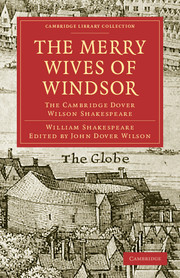TO THE READER
Published online by Cambridge University Press: 07 September 2010
Summary
The following is a brief description of the punctuation and other typographical devices employed in the text, which have been more fully explained in the Note on Punctuation and the Textual Introduction to be found in The Tempest volume:
An obelisk (†) implies corruption or emendation, and suggests a reference to the Notes.
A single bracket at the beginning of a speech signifies an ‘aside.’
Four dots represent a full-stop in the original, except when it occurs at the end of a speech, and they mark a long pause.
Original colons or semicolons, which denote a somewhat shorter pause, are retained, or represented as three dots when they appear to possess special dramatic significance.
Similarly, significant commas have been given as dashes.
Round brackets are taken from the original, and mark a significant change of voice; when the original brackets seem to imply little more than the drop in tone accompanying parenthesis, they are conveyed by commas or dashes.
In plays for which both Folio and Quarto texts exist, passages taken from the text not selected as the basis for the present edition will be enclosed within square brackets.
Single inverted commas (‘ ’) are editorial; double ones (“ ”) derive from the original, where they are used to draw attention to maxims, quotations, etc.
The reference number for the first line is given at the head of each page. Numerals in square brackets are placed at the beginning of the traditional acts and scenes.
- Type
- Chapter
- Information
- The Merry Wives of WindsorThe Cambridge Dover Wilson Shakespeare, pp. xlPublisher: Cambridge University PressPrint publication year: 2009First published in: 1921

